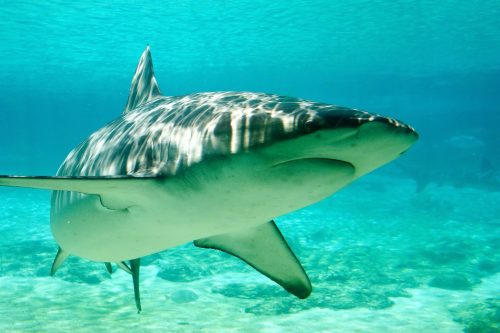
Carcharhinus obscurus
Dusky sharks are wide-ranging coastal and pelagic species that prefer temperate to tropical waters. They are large-bodied, typically grey with dusky margins on the fins. They are an important fisheries resource, targeted and taken as bycatch around the world. Their fins are highly valued. Because dusky sharks are very slow growing, mature late and have small litters they are particularly vulnerable to overexploitation.
Order: Carcharhiniformes
Family: Carcharhinidae
Genus: Carcharhinus
Species: obscurus
Common Names
Common English language names for this shark include dusky shark, black whaler, common whaler. Other names include tiburón arenero (Spanish), donkerhaai (Afrikaans), dotabuka (Japanese), marracho areneiro (Portuguese), requiem de sable (French).
Importance to Humans
Dusky sharks are used for human consumption, leather and liver oil. Both the meat and fins are highly-valued. They are targeted and taken as bycatch in commercial, recreational and artisanal fisheries over much of their range including in the northwestern, western-central and southwestern Atlantic, the Mediterranean, the Pacific Ocean around Australia and in the Indian and southeastern Atlantic Oceans off South Africa. Populations are estimated to have declined in many of these locations.
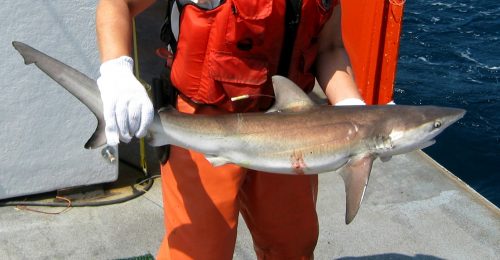
Danger to Humans
Dusky sharks are potentially dangerous due to their large size and occurrence in shallow coastal waters, though they have been implicated in few interactions with humans. They are frequently encountered in beach meshing programs in Australia and South Africa.
Conservation
IUCN Red List Status: Vulnerable
Dusky sharks have a very low rate of natural increase because of their slow growth rate, late age at maturation and small litter sizes. This makes them particularly susceptible to population declines as a consequence of anthropogenic pressures. Dusky sharks are harvested in beach meshing programs and fisheries around the world. They are also popular in the shark fin trade (Clarke et al 2006a, 2006b; Fields et al 2018).
Dusky shark populations have declined significantly in the Northwest and Western central Atlantic. It was estimated that current population sizes represent approximately 15-20% of their mid-1970s abundance (Cortes et al. 2006). Despite landing prohibitions and stock rebuilding plans introduced during the 2000s, overfishing continues and the stock remains overfished (SEDAR 2011). Australian populations declined by over 75% from the 1970s-2004 as a consequence of overfishing and management measures were introduced in the mid 2000s. The stock is currently considered sustainably managed and recovering (Braccini and O’Malley 2017).
Dusky sharks are considered globally Vulnerable according the International Union for the Conservation of Nature Red List threatened species criteria.
> Check the status of the dusky shark at the IUCN website.
Geographical Distribution
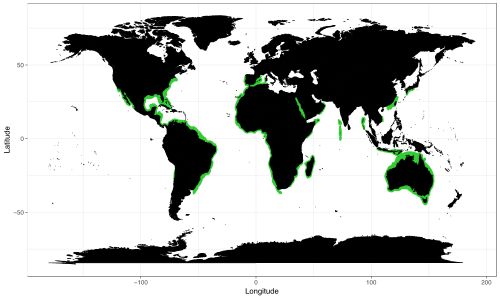
The dusky shark is a cosmopolitan species that occurs along continental coastlines and the shelf in tropical and temperate waters. It ranges from Nova Scotia to Cuba (including the northern Gulf of Mexico) and from Nicaragua to southern Brazil in the western Atlantic and from southern California to the Gulf of California in the eastern Pacific. It is also found in the Mediterranean, Indo-western Pacific including Madagascar and Australia.
Habitat
Dusky sharks are highly migratory, ranging from shallow inshore waters to the outer continental shelf and adjacent oceanic waters. Adults of this species tend to avoid areas of low salinity and rarely enter estuaries. Nursery grounds have been identified in shallow inshore waters off the southern coast of KwaZulu-Natal, South Africa (Bass et al. 1973), along the east coast of the United States (Musick and Colvocoresses 1988, Castro 1993), and off the southwest coast of Australia (McAuley and Simpfendorfer 2003; Braccini and Taylor 2016). Dusky sharks make large scale seasonal migrations, often covering thousands of kilometers per migration event. In the western Atlantic and eastern Pacific, animals move north during the summer and south in the winter. In South Africa and Australia, dusky sharks move north during the austral winter–spring and south during the austral summer–autumn (Hussey et al 2009; Braccini et al 2017; Rogers et al 2013). Dusky sharks are also known to segregate by both size and sex.
Distinguishing Characteristics
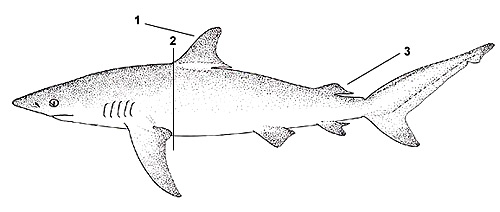
1. First dorsal fin slopes
2. First dorsal fin originates over or slightly before free tips of pectoral fins
3. Second dorsal fin has a free tip length rarely more than twice the fin height
Biology
Distinctive Features
Dusky sharks are most frequently confused with Galapagos sharks, (Carcharhinus galapagensis). These species have hybridized in the past meaning that they are indistinguishable using traditional molecular barcoding methods (Corrigan et al. 2017). Their external morphology is superficially very similar but they they have different numbers of pre-caudal vertebrae (Garrick 1982), as well as marked and consistent differences in onset of maturity (Natanson et al. 1995; Simpfendorfer et al. 2002; Wetherbee et al. 1996). They also occupy separate ecological niches with dusky sharks most commonly found along continental margins while Galapagos sharks prefer offshore islands and seamounts. Dusky sharks are also confused with other species of Carcharhinus, particularly silky sharks (Carcharhinus falciformis) and the sandbar shark (Carcharhinus plumbeus). Dusky sharks have low rounded dorsal fins (1), large falcate pectoral fins, a low interdorsal ridge, the first dorsal fin originates over or slightly before free tips of the pectoral fins (2) the second dorsal fin has a free tip length rarely more than twice the fin height (3).

Coloration
Typical of many of the carcharhinids, the dusky shark is bluish gray above with a white underside. Fin margins are dusky but may be inconspicuous in adults.
Dentition
Upper teeth are triangular and slightly oblique with serrated edges. Lower teeth are erect, narrowly cusped and more finely serrated.

Denticles
The dermal denticles for C. obscurus are large, closely imbricated, and show five keels with five distinct pointed obes. The denticles rest on a large rhomboidal base plate.
Size, Age, and Growth
Dusky sharks are very slow growing. Age at maturity varies with location but generally falls between 16-23 years for males and 16-22 years for females (Natanson et al.1995; Simpfendorfer et al 2002; Joung et al 2015). Size at birth ranges from 70-100 cm (33-39 in). Maximum length ranges 360-400 cm (11.8 ft).
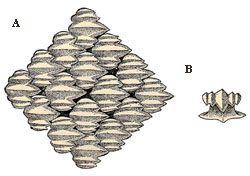
Food Habits
Dusky sharks prey primarily on bony and cartilaginous fishes as well as crustaceans and cephalopods (Ebert et al 2013).
Reproduction
Dusky sharks are live-bearing and nourish their young in utero with a yolk-sac placenta. They have 3-16 pups after a 18-22 month gestation. They breed every two to three years. Females generally migrate inshore to pup (Castro 2009, Romine 2009, Compagno 1984, Ebert et al 2013).
Predators
Young dusky sharks may fall prey to larger sharks including the bull shark. Mature dusky sharks have few if any predators.
Taxonomy
Lesueur first described the dusky shark in 1818 as Squalus obscurus, later renaming it Carcharhinus obscurus. The genus name Carcharhinus is derived from the Greek “karcharos” = sharpen and “rhinos” = nose. Obscurus can be translated from Latin as “dark, indistinct.” Since its original description, this shark has appeared in the literature under several different names, including Geleolamna greyi Owen 1853, Carcharias macrurus Ramsay & Ogilby 1887, Galeolamna (Galeolamnoides) eblis Whitley 1944, Carcharhinus iranzae Fourmanoir 1961, and Carcharhinus obscurella Deng, Xiong & Zhan 1981.
References
Bass AJ, D’aubrey D and Kistnasamy N (1973) Sharks of the east coast of southern Africa. The genus Carcharhinus (Carcharhinidae). Issue 33 Investigational Report Oceanographic Research Institute 168 pp.
Braccini M and O’Malley J (2017) Temperate demersal gillnet and demersal longline fisheries status report. In Status reports of the fisheries and aquatic resources of Western Australia 2015/16: The State of Fisheries.
Fletcher WJ, Mumme MD and Webster FJ (eds). Department of Fisheries of Western Australia, Perth. pp. 202–206.
Braccini M and Taylor S (2016) The spatial segregation patterns of sharks from Western Australia. Royal Society Open Science 3: 160306.
Braccini M, de Lestang S, McAuley R (2017) Dusky sharks (Carcharhinus obscurus) undertake large-scale migrations between tropical and temperate ecosystems Canadian Journal of Fisheries and Aquatic Sciences Published on the web 07 December 2017, https://doi.org/10.1139/cjfas-2017-0313.
Castro JI (1993) The shark nursery of Bulls Bay, South Carolina, with a review of the shark nurseries of the southeastern coast of the United States. Environmental Biology of Fishes 38: 37–48.
Castro, JI (2009) Observations on the reproductive cycles of some viviparous North American sharks. Aqua 15: 205–222.
Clarke S, Magnusson JE, Abercrombie DL, McAllister M and Shivji MS (2006) Identification of shark species composition and proportion in the Hong Kong shark fin market using molecular genetics and trade records. Conservation Biology 20: 201–211.
Clarke SC, McAllister MK, Milner-Gulland EJ, Kirkwood GP, Michielsens CGJ, Agnew DJ, Pikitch EK, Nakano H and Shivji MS (2006) Global estimates of shark catches using trade records from commercial markets. Ecology Letters 9: 1115–1126.
Corrigan S, Maisano-Delser P, Eddy C, Duffy C, Yang L, Li C, Bazinet AL, Mona S, Naylor GJP (2017) Historical introgression drives pervasive mitochondrial admixture between two species of pelagic sharks Molecular Phylogenetics and Evolution 110 122–126.
Cortés E, Brooks E, Apostolaki P and Brown CA (2006) Stock assessment of dusky shark in the US Atlantic and Gulf of Mexico. Sustainable Fisheries Division Contribution SFD-2006-014, Panama City Laboratory Contribution 06-05.
Fields AT, Fischer GA, Shea SKH, Zhang H, Abercrombie DL, Feldheim KA, Babcock EA and Chapman DD (2018) Species composition of the international shark fin trade assessed through a retail-market survey in Hong Kong. Conservation Biology 32: 376–389
Hussey NE, McCarthy ID, Dudley SFJ, Mann BQ (2009) Nursery grounds, movement patterns and growth rates of dusky sharks, Carcharhinus obscurus: a long-term tag and release study in South African waters. Marine and Freshwater Research 60: 571–583.
Joung S, Chen J, Chin C, Liu K (2015) Age and Growth of the Dusky Shark, Carcharhinus obscurus, in the Western North Pacific Ocean. Terrestrial Atmospheric and Oceanic Sciences 26: 53–160.
McAuley R and Simpfendorfer C (2003) Catch composition of the Western Australian temperate demersal gillnet and demersal longline fisheries, 1994 to 1999. Fisheries Research Report No. 146, Department of Fisheries, Western Australia.
McAuley R, Lenanton R, Chidlow J, Allison R and Heist E (2005). Biology and stock assessment of the thickskin (sandbar) shark, Carcharhinus plumbeus, in Western Australia and further refinement of the dusky shark, Carcharhinus obscurus, stock assessment. FRDC Project No. 2000/134. Fisheries Research Report no. 151. Department of Fisheries, Western Australia, 132 pp.
Musick JA and Colvocoresses JA (1988) Seasonal recruitment of subtropical sharks in Chesapeake Bight, USA. In: Yanez A, Arancibia Y and Pauly D (eds.) Workshop on recruitment in tropical coastal demersal communities. Campeche, Mexico, 21–25 April 1986. FAO/UNESCO, I.O.C. Workshop Rept. No. 44.
Natanson LJ, Casey JG, and Kohler NE (1995) Age and growth estimates for the dusky shark, Carcharhinus obscurus, in the western North Atlantic Ocean. Fisheries Bulletin 93: 116–126.
Rogers PJ, Huveneers C, Goldsworthy SD, Mitchell JG, Seuront L (2013) Broad-scale movements and pelagic habitat of the dusky shark Carcharhinus obscurus off Southern Australia determined using pop-up satellite archival tags. Fisheries Oceanography 22: 102–112.
Romine J, Musick J and Burgess G (2009) Demographic analyses of the dusky shark, Carcharhinus obscurus, in the Northwest Atlantic incorporating hooking mortality estimates and revised reproductive parameters. Environmental Biology of Fishes 84: 277–289.
SEDAR (2011) SEDAR 21 Highly migratory species sandbar shark, dusky shark, and blacknose shark stock assessment report. SEDAR, North Charleston, SC. Retrieved from http://www.sefsc.noaa.gov/sedar/ Index.jsp
Simpfendorfer CA, McAuley R, Chidlow J and Unsworth P (2002) Validated age and growth of the dusky shark, Carcharhinus obscurus, from Western Australian waters. Marine and Freshwater Research 53: 567–573.
Wetherbee B, Crow G and Lowe C (1996) Biology of the Galapagos shark, Carcharhinus galapagensis, in Hawaii. Environmental Biology of Fishes 45: 299–310.
Revised by Shannon Corrigan and Gavin Naylor 2018
Original preparation by Craig Knickle